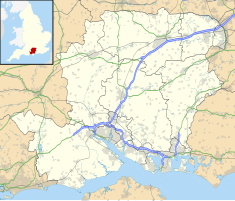The Vyne
| The Vyne | |
|---|---|
 The north front | |
| Type | Country house |
| Location | Sherborne St John |
| Coordinates | 51°18′25″N 1°5′18″W / 51.30694°N 1.08833°WCoordinates: 51°18′25″N 1°5′18″W / 51.30694°N 1.08833°W |
| OS grid reference | SU 63627 56816 |
| Area | Hampshire |
| Built | 16th Century |
| Owner | National Trust |
Listed Building – Grade I | |
| Official name | The Vyne |
| Designated | 26 April 1957 |
| Reference no. | 1296972 |
National Register of Historic Parks and Gardens | |
| Official name | The Vyne |
| Designated | 31 May 1984 |
| Reference no. | 1000870 |
 Location of The Vyne in Hampshire | |


The Vyne is a 16th-century estate and country house outside Sherborne St John near Basingstoke in Hampshire, England. It is a Grade I listed building.[1]
History[]
The Vyne was built for Lord Sandys, Henry VIII's Lord Chamberlain.[2] The house retains its Tudor chapel, with stained glass. The classical portico on the north front, the first of its kind in England, was added in 1654 by Inigo Jones's pupil John Webb[3] for the lawyer and politician Chaloner Chute.[4] In the mid-eighteenth century The Vyne belonged to Horace Walpole's close friend , who designed the Palladian staircase, whose magnificent apparent scale belies its actual small size.[3]
In 1827, The Vyne was inherited by William Lyde Wiggett Chute[5] from the reverend .[6] Chute lived there from the death of Elizabeth Chute, widow of , in 1842 until his death in 1879 during which time he greatly improved the estate, particularly the access routes which were known for their poor quality. Horace Walpole had described them in the eighteenth century as so bad that the house "must be approached upon stilts".[6] His improvements were recorded in articles[7] that he wrote for the journal of the Royal Agricultural Society of England.[6]
The Vyne was bequeathed by its final Chute owner, Charles Chute, to the National Trust in 1956.[8]
The Vyne's roof underwent a two-year-long, £5.4 million restoration project before the house was fully reopened in October 2018.[9]
In 2018, conservationists undertook the six-month restoration and cataloguing of the 2,500 books in the library at The Vyne, and have uncovered a number of centuries-old doodles in the margins of the collection's books.[10][9]
Possible inspiration for Lord of the Rings[]
The Vyne holds an inscribed Roman ring as well as a lead tablet that speaks of a curse on the one who stole it. J. R. R. Tolkien was asked to comment on it as an expert on Anglo-Saxon history, including its connection to a mine fabled to have been dug by dwarves, and a few days after began writing Lord of the Rings.[11][12] Tolkien scholar and writer, John Garth, in his book, The Worlds of J.R.R. Tolkien, argues that this claim is tenuous from an examination of Tolkien's own notes and drafts. He explains the differences between the two rings: the curse on Sauron's Ring is on the ring itself, but the Curse of Silvianus is on the lead tablet and showing the story of Bilbo's ring being written before Tolkien's acquaintance with the ring at the Vyne.[13]
References[]
- ^ Historic England. "The Vyne (1296972)". National Heritage List for England. Retrieved 21 March 2019.
- ^ The Vyne. Images of England, Historic England. Retrieved 29 June 2018.
- ^ a b Howard, Maurice (2015). The Vyne. Swindon: National Trust. p. 8. ISBN 978-1-84359-022-4.
- ^ Express, Britain. "The Vyne, Basingstoke, Hampshire | Historic Hampshire Guide". Britain Express. Retrieved 20 November 2018.
- ^ Woodcock, Thomas; Robinson, John Martin (2000). Heraldry in National Trust Houses. National Trust, Aylesbury. p. 181.
- ^ a b c Chute, Chaloner William (1888). A History of the Vyne in Hampshire: Being a Short Account of the Building & Antiquities of that House &c. Winchester: Jacob & Johnson. pp. 131–133.
- ^ "Farming in Hampshire", Vol. XLVIII.
- ^ "Brief history of the house at The Vyne". National Trust. Retrieved 15 February 2017.
- ^ a b "See inside The Vyne as it fully reopens after £5.4m refurb". Basingstoke Gazette. Retrieved 20 November 2018.
- ^ Flood, Alison (20 November 2018). "Eighteenth-century schoolboy's doodles uncovered as library is restored". the Guardian. Retrieved 20 November 2018.
- ^ Maev Kennedy (2 April 2013). "The Hobbit ring that may have inspired Tolkien put on show". The Guardian. Retrieved 15 April 2013.
- ^ NPR: J.R.R. Tolkien's Ring On Display At Estate's Exhibit
- ^ The Worlds of J.R.R. Tolkien, Appendix, pages 187–188
Further reading[]
- Chute, Francis. (2005) The Chutes of the Vyne: An Illustrated History of the Chute Family and Their 300 Year Connection with Stately Home The Vyne at Basingstoke in Hampshire. Woodfield Publishing. ISBN 978-1903953921
External links[]
| Wikimedia Commons has media related to The Vyne. |
- Country houses in Hampshire
- Gardens in Hampshire
- National Trust properties in Hampshire
- Historic house museums in Hampshire
- Basingstoke and Deane
- Grade I listed houses
- Grade I listed buildings in Hampshire
- Grade I listed museum buildings
- Chute family
